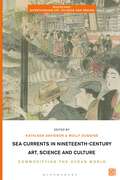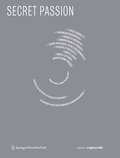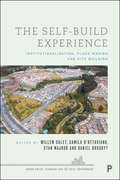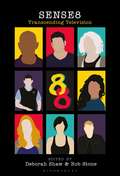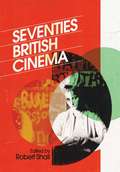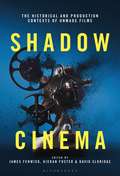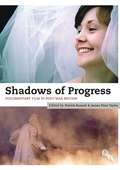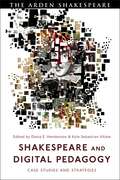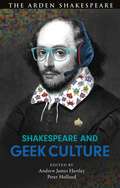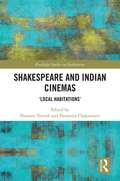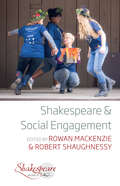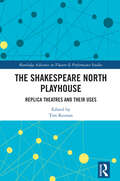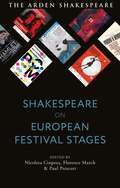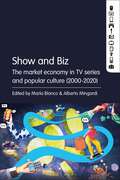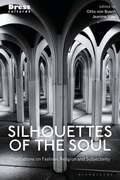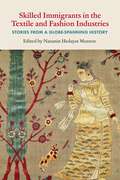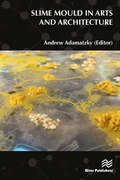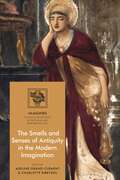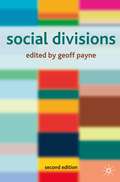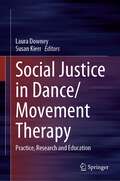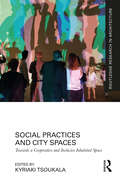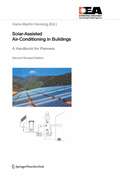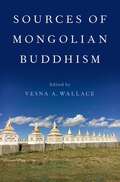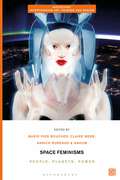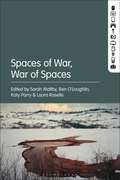- Table View
- List View
Sea Currents in Nineteenth-Century Art, Science and Culture: Commodifying the Ocean World (Biotechne: Interthinking Art, Science and Design)
How did scientists, artists, designers, manufacturers and amateur enthusiasts experience and value the sea and its products? Examining the commoditization of the ocean world during the nineteenth century, this book demonstrates how the transaction of oceanic objects inspired a multifaceted material discourse stemming from scientific exploration, colonial expansion, industrialization, and the rise of middle-class leisure. From the seashore to the seabed, marine organisms and environments, made tangible through processing and representational technologies, captivated practitioners and audiences. Combining essays and case studies by scholars, curators, and scientists, Sea Currents investigates the collecting and display, illustration and ornamentation, and trade and consumption of marine flora and fauna, analysing their material, aesthetic and commercial dimensions. Traversing global art history, the history of science, empire studies, anthropology, ecocriticism and material culture, this book surveys the currency of marine matter embedded in the economies and ecologies of a modernizing ocean world.
Secret Passion: Künstler und ihre Musik-Leidenschaften / Artists and their musical desires (Edition Angewandte)
CM VON HAUSSWOLFF: Ist hier irgendwer, der mit dieser Musik Coca-Cola-Flaschen v- kaufen würde? EDEK BARTZ: Naja,warten wir’s ab.Man weiß nie.Die Zeiten ändern sich.Ganz herzlichen Dank für diese Einführung in die elektronische Musik,dafür,dass du uns all ihre Gehe- nisse verraten hast. Es war wirklich interessant. (Zum Publikum gewandt) Wenn es euch interessiert: Die Bibliothek besitzt auch eine Serie von CDs mit elektronischer Musik,die ihr hier anhören könnt, und eine sehr in- ressante Geschichte der elektronischen Musik.Ich empfehle auch wärmstens vier CDs über das,was uns Carl Michael heute über die Anfänge der elektronischen Musik erzählt hat,von den allerersten Geräten bis heute. Es gibt in der Bibliothek auch Kataloge von verschiedenen Ausstellungen, die sich mit diesem Sound beschäftigt haben. Die kann man anschauen und ausleihen. Lasst mich nun Carl Michael nochmals dafür danken, dass er heute hier bei uns war, und für das wundervolle Gespräch.Vielen Dank. 131 SECRET PASSION 5 CARL MICHAEL VON HAUSSWOLFF 13 132 2 CARL MICHAEL VON HAUSSWOLFF talks to EDEK BARTZ about electronic music… EDEK BARTZ: I would like to begin by briefly explaining our format. Our series is not s- posed to be a major educational project; we do not want to go the academic way. On the contrary it should be enjoyable–a talk about the passion of the invited artists, about their passion for music. I never know beforehand what they are going to play.
The Self-Build Experience: Institutionalization, Place-Making and City Building (Urban Policy, Planning and the Built Environment)
Using a broad international comparative perspective spanning multiple countries across South America, Europe and Africa, contributors explore resident-led self-building for low and middle income groups in urban areas. Although social, economic and urban prosperity differs across these contexts, there exists a recurring, cross-continental, tension between formal governance and self-regulation. Contributors examine the multi-faceted regulation dilemmas of self-building under the conditions of modernization and consider alternative methods of institutionalization, place-making and urban design, reconceptualizing the moral and managerial ownership of the city. Innovative in scope, this book provides an array of globalized solutions for navigating regulatory tensions in order to optimize sustainable development for the future
Sense8: Transcending Television
This collection explores the many ways in which the Netflix series Sense8 transcends television. As its characters transcend physical and psychological borders of gender and geography, so the series itself transcends those between television, new media platforms and new screen technologies, while dissolving those between its producers, stars, audiences and fans. Sense8 united, inspired and energized a global community of fans that realized its own power by means of online interaction and a successful campaign to secure a series finale. The series' playful but poignant exploration of globalization, empathy, transnationalism, queer and trans aesthetics, gender fluidity, imagined communities and communities of sentiment also inspired the interdisciplinary range of contributors to this volume. In this collection, leading academics illuminate Sense8 as a progressive and challenging series that points to vital, multifarious, contemporary social, political, aesthetic and philosophical concerns. Sense8: Transcending Television is much more than an academic examination of a series; it is an account and analysis of the way that we all receive, communicate and consider ourselves as participants in global communities that are social, political and cultural, and now both physical and virtual too.
Seventies British Cinema
Seventies British Cinema provides a comprehensive re-evaluation of British film in the 1970s. The decade has long been written off in critical discussions as a 'doldrums' period in British cinema, perhaps because the industry, facing near economic collapse, turned to 'unacceptable' low culture genres such as sexploitation comedies or extreme horror. The contributors to this new collection argue that 1970s cinema is ripe for reappraisal: giving serious critical attention to populist genre films, they also consider the development of a British art cinema in the work of Derek Jarman and Peter Greenaway, and the beginnings of an independent sector fostered by the BFI Production Board and producers like Don Boyd. A host of highly individual directors managed to produce interesting and cinematically innovative work against the odds, from Nicolas Roeg to Ken Russell to Mike Hodges. As well as providing a historical and cinematic context for understanding Seventies cinema, the volume also features chapters addressing Hammer horror, the Carry On films, Bond films of the Roger Moore period, Jubilee and other films that responded to Punk rock; heritage cinema and case studies of key seventies films such as The Wicker Man and Straw Dogs. In all, the book provides the final missing piece in the rediscovery of British cinema's complex and protean history. Contributors: Ruth Barton, James Chapman, Ian Conrich, Wheeler Winston Dixon, Christophe Dupin, Steve Gerrard, Sheldon Hall I. Q. Hunter, James Leggott, Claire Monk, Paul Newland, Dan North, Robert Shail, Justin Smith and Sarah Street.
Shadow Cinema: The Historical and Production Contexts of Unmade Films
Filmmakers and cinema industries across the globe invest more time, money and creative energy in projects and ideas that never get produced than in the movies that actually make it to the screens. Thousands of projects are abandoned in pre-production, halted, cut short, or even made and never distributed – a “shadow cinema” that exists only in the archives. This collection of essays by leading scholars and researchers opens those archives to draw on a wealth of previously unexamined scripts, correspondence and production material, reconstructing many of the hidden histories of the last hundred years of world cinema. Highlighting the fact that the movies we see are actually the exception to the rule, this study uncovers the myriad reasons why 'failures' occur and considers how understanding those failures can transform the disciplines of film and media history. The first survey of this new area of empirical study across transnational borders, Shadow Cinema is a vital and fascinating demonstration of the importance of the unmade, unseen, and unknown history of cinema.
Shadows of Progress: Documentary Film in Post-War Britain
Britain emerged from war a changed country, facing new social, industrial and cultural challenges. Its documentary film tradition – established in the 1930s and 1940s around legendary figures such as Grierson, Rotha and Jennings – continued evolving, utilising technical advances, displaying robust aesthetic concerns, and benefiting from the entry into the industry of wealthy commercial sponsors. Thousands of films were seen by millions worldwide. Received wisdom has been that British documentary went into swift decline after the war, resurrected only by Free Cinema and the arrival of television documentary. Shadows of Progress demolishes these simplistic assumptions, presenting instead a complex and nuanced picture of the sponsored documentary in flux. Patrick Russell and James Piers Taylor explore the reasons for the period's critical neglect, and address the sponsorship, production, distribution and key themes of British documentary. They paint a vivid picture of institutions – from public bodies to multinational industries – constantly redefining their relationships with film as a form of enlightened public relations. Many of the issues that these films addressed could not be more topical today: the rise of environmentalism; the balance of state and industry, individual and community; a nation and a world travelling from bust to boom and back again. In the second part of the book, contributors from the curatorial and academic world provide career biographies of key film-makers of the period. From Lindsay Anderson's lesser-known early career to neglected film-makers like John Krish, Sarah Erulkar, Eric Marquis and Derrick Knight, a kaleidoscopic picture is built up of the myriad relationships of artist and sponsor.
Shakespeare and Digital Pedagogy: Case Studies and Strategies
Shakespeare and Digital Pedagogy is an international collection of fresh digital approaches for teaching Shakespeare. It describes 15 methodologies, resources and tools recently developed, updated and used by a diverse range of contributors in Great Britain, Australia, Asia and the United States. Contributors explore how these digital resources meet classroom needs and help facilitate conversations about academic literacy, race and identity, local and global cultures, performance and interdisciplinary thought. Chapters describe each case study in depth, recounting needs, collaborations and challenges during design, as well as sharing effective classroom uses and offering accessible, usable content for both teachers and learners.The book will appeal to a broad range of readers. College and high school instructors will find a rich trove of usable teaching content and suggestions for mounting digital units in the classroom, while digital humanities and education specialists will find a snapshot of and theories about the field itself. With access to exciting new content from local archives and global networks, the collection aids teaching, research and reflection on Shakespeare for the 21st century.
Shakespeare and Geek Culture
From fantasy and sci-fi to graphic novels, from boy scouts to board games, from blockbuster films to the cult of theatre, Shakespeare is everywhere in popular culture. Where there is popular culture there are fans and nerds and geeks. The essays in this collection on Shakespeare and Geek Culture take an innovative approach to the study of Shakespeare's cultural presences, situating his works, his image and his brand to locate and explore the nature of that geekiness that, the authors argue, is a vital but unrecognized feature of the world of those who enjoy and are obsessed by Shakespeare, whether they are scholars, film fans, theatre-goers or members of legions of other groupings in which Shakespeare plays his part.Working at the intersections of a wide range of fields ? including fan studies and film analysis, cultural studies and fantasy/sci-fi theory – the authors demonstrate how the particularities of the connection between Shakespeare and geek culture generate new insights into the plays, poems and their larger cultural legacy in the 21st century.
Shakespeare and Indian Cinemas: "Local Habitations" (Routledge Studies in Shakespeare)
This book is the first to explore the rich archive of Shakespeare in Indian cinemas, including less familiar, Indian language cinemas to contribute to the assessment of the expanding repertoire of Shakespeare films worldwide. Essays cover mainstream and regional Indian cinemas such as the better known Tamil and Kannada, as well as the less familiar regions of the North Eastern states. The volume visits diverse filmic genres, starting from the earliest silent cinema, to diasporic films made for global audiences, television films, independent films, and documentaries, thus expanding the very notion of ‘Indian cinema’ while also looking at the different modalities of deploying Shakespeare specific to these genres. Shakespeareans and film scholars provide an alternative history of the development of Indian cinemas through its negotiations with Shakespeare focusing on the inter-textualities between Shakespearean theatre, regional cinema, performative traditions, and literary histories in India. The purpose is not to catalog examples of Shakespearean influence but to analyze the interplay of the aesthetic, historical, socio-political, and theoretical contexts in which Indian language films have turned to Shakespeare and to what purpose. The discussion extends from the content of the plays to the modes of their cinematic and intermedial translations. It thus tracks the intra–Indian flows and cross-currents between the various film industries, and intervenes in the politics of multiculturalism and inter/intraculturalism built up around Shakespearean appropriations. Contributing to current studies in global Shakespeare, this book marks a discursive shift in the way Shakespeare on screen is predominantly theorized, as well as how Indian cinema, particularly ‘Shakespeare in Indian cinema’ is understood.
Shakespeare and Social Engagement (Shakespeare & #10)
Shakespeare’s roots in applied and participatory performance practices have been recently explored within a wide variety of educational, theatrical and community settings. Shakespeare and Social Engagement explores these settings, as well as audiences who have largely been excluded from existing accounts of Shakespeare’s performance history. The contributions in this collected volume explore the complicated and vibrant encounters between a canonical cultural force and work that frequently characterizes itself as inclusive and egalitarian.
The Shakespeare North Playhouse: Replica Theatres and Their Uses (ISSN)
This collection celebrates the opening of the Shakespeare North Playhouse (SNP). After discussion of its genesis and development by four people pivotal to its progress at different stages of the project, this book explores different aspects of the SNP’s purpose and functions across three broad categories: buildings and spaces, practices and performance, and community arts and education. Various chapters offer answers to fundamental questions about replica theatres, including: Why do we build them? What do they do? How do we use them? In the course of these discussions, the purposes, potential, and programming of the SNP are discussed in relation to other Globe-type replicas in the UK and beyond. Contributors to this collection analyse key academic and practice-based concerns within their fields of expertise connected to the use (and misuse) of replica theatres to suggest the ways in which they can be used to drive research and practice in contemporary Shakespearean performance, connect with young people, and serve local communities.This book will appeal to academics, students, and practitioners interested in historical and contemporary approaches to Shakespeare in the fields covered. It should also appeal to general readers with an interest in the topics, particularly in Merseyside and the North-West region.
Shakespeare on European Festival Stages
From the aftermath of World War II to the convulsions of Brexit, festivals have deployed Shakespeare as a model of inclusive and progressive theatre to seek cultural solutions to Europe's multi-faceted crises. Shakespeare on European Festival Stages is the first book to chart Shakespeare's presence at continental European festivals. It examines the role these festivals play in European socio-cultural exchanges, and the impact festivals make on the wider production and circulation of staged Shakespeare across the continent. This collection offers authoritative, lively and informed accounts of the production of Shakespeare at the following festivals: the Avignon Festival and Le Printemps des comédiens in Montpellier (France), the Almagro festival (Spain), Shakespeare at Four Castles (Czech Republic and Slovakia), the International Shakespeare Festival in Craiova (Romania), the Shakespeare festivals in Elsinore (Denmark), Gdansk (Poland), Gyula (Hungary), Itaka (Serbia), Neuss (Germany), Patalenitsa (Bulgaria), Rome and Verona (Italy).Shakespeare on European Festival Stages is essential reading for students, scholars and practitioners interested in Shakespeare in performance, in translation and in a post-national Shakespeare that knows no borders and belongs to all of Europe.
Show and Biz: The market economy in TV series and popular culture (2000-2020)
How is capitalism represented in popular culture today? Are profits seen as a legitimate reward of entrepreneurship? Are thrift and effort still considered a cornerstone of a healthy society? Or is it that inequalities are eliciting scandal and reproach? How is the ecosystem portrayed, vis-à-vis profit seeking companies? Are they irreconcilable, or maybe not? Are there any established trends with respect to the presentation of entrepreneurship, and that complex legal artefact that is the modern limited liability company? These are questions that will be at the core of this book. But they are not examined through the usual theoretical point of references, but looking at TV series produced in 2000-2020. Each chapter of this book is a case studies, covering some of the most popular, successful and engaging TV shows of the last 20 years. And showing how deep economic ideas and biases lie, at the roots of some of our times' most successful entertainment products.
Silhouettes of the Soul: Meditations on Fashion, Religion, and Subjectivity (Dress Cultures)
What is the relationship between the soul, or inner life, and what we wear in the making of identity and belief? What bearing do religious and political belonging, respectability, and resistance have on the way in which we dress? Why have more traditional religious practices been so prescriptive about body adornment? Historically, fashionable dress and religion have been positioned as polar opposites. Silhouettes of the Soul brings them together, placing them in conversation with each other. By moving beyond traditional, social scientific, and historical analysis of religious attire and adornment the book presents a variety of disciplinary approaches from across regional, social, and religious locations.Contentious and challenging, as well as academically rigorous, the book's diverse range of contributors - from fashion and religious studies scholars, to designers, activists, monastics, and journalists - explore the relationship between religion and fashion, extending the meanings and possibilities of both dress and spirituality. Combining interviews and personal stories with more traditional theoretical analysis, Silhouettes of the Soul offers new ways of looking at the relationship between religion, personal convictions, and self-expression - our sense of self and our sense of fashion.
Skilled Immigrants in the Textile and Fashion Industries: Stories from a Globe-Spanning History
With contributions from leading experts, this edited collection presents original research on the skills brought by immigrant communities to the textile and fashion industries, from the early modern to postmodern periods in Asia and the Islamic World, Europe, Africa, and the Americas.Manufacturing of textiles and apparel is arduous work, which historically depended on skilled artisans, inexpensive labor, and the introduction of labor-saving technology. Immigrant communities supplied much of the work force, bringing their own skill sets to new locations, leading to the development of new manufacturing centers and an increase in both production and technical expertise. Throughout the volume, the role of migration and immigrant involvement in manufacturing is also examined in relation to trade, politics, and socio-religious circumstances prompting relocation.Deconstructing the question of provenance by examining the cultural identity of migrant populations, the research brings to light ongoing dilemmas and practices of diaspora communities. By analyzing material, mythical, and technical aspects of textile and apparel production, contributors create a new narrative about textile- and garment-making as a collective endeavor, requiring diversity of skill and methodology to thrive.
Slime Mould in Arts and Architecture
The slime mould Physarum polycephalum was a source of explosive growth of bioengineered hybrid sensing and computing devices in the past decade. Being in its vegetative state, the plasmodium, the slime mould configures its protoplasmic network to optimize its geometry with relation to patterns of attractants and repellents.The slime mould’s adaptability, polymorphism and aestheticism inspired artists and architects. The slime mould has been seen as a self-conscious liquid form continuously changing its shape in response to external stimulation and due to interactions of thousands of micro-oscillators in its body. Elusiveness is a magic feature of the slime mould. One moment the slime mould gives you a solution to a mathematical problem by a shape of its body, next moment it changes its shape and the solution ,disappears.Slime Mould in Arts and Architecture presents a set of unique chapters written by leading artists, architects and scientists, which resulted from creative translations of the slime mould behaviour into forms and sounds, unconventional investigations and sensorial experiences and the slime mould ability to remove boundaries between living and artificial, solid and fluid, science and arts. The book gives readers unique tools for designing architectural forms and creative works using the slime mould, understanding how pro-cognitive living substrates can be used in everyday life, it sparks new ideas and initiates further progress in many fields or arts, architecture, science and engineering.
The Smells and Senses of Antiquity in the Modern Imagination (IMAGINES – Classical Receptions in the Visual and Performing Arts)
This volume tackles the role of smell, under-explored in relation to the other senses, in the modern rejection, reappraisal and idealisation of antiquity. Among the senses olfaction in particular has often been overlooked in classical reception studies due to its evanescent nature, which makes this sense difficult to apprehend in its past instantiations. And yet, the smells associated with a given figure or social group convey a rich imagery which in turn connotes specific values: perfumes, scents and foul odours both reflect and mould the ways in which a society thinks or acts. Smells also help to distinguish between male and female, citizens and strangers, and play an important role during rituals. The Smells and Senses of Antiquity in the Modern Imagination focuses on the representation of ancient smells - both enticing and repugnant - in the visual and performative arts from the late 18th century up to the 21st century. The individual contributions explore painting, sculpture, literature and film, but also theatrical performance, museum exhibitions, advertising, television series, historical reenactment and graphic novels, which have all played a part in reshaping modern audiences' perceptions and experiences of the antique.
Social Divisions
Society consists of people sharply divided from one another, living different lives and with distinct identities. This updated and expanded second edition of a successful text explores each of the social divisions. The book includes three major new chapters, on religion, poverty and elites and is written by leading academics in each field.
Social Justice in Dance/Movement Therapy: Practice, Research and Education
This book demonstrates the use of dance/movement therapy to directly counteract social injustices and promote healing in international settings. It also demonstrates the potential for dance/movement therapy in prevention and wellness in clinical and community settings. The use of improvisational and creative dance is presented throughout the book as a tremendously clear, strong and powerful inroad to healing in every setting. The chapters in this book do not directly address social justice in dance/movement therapy, but rather provide provoking social justice related positions. This call for a provoking re-examination of the definition of dance/movement therapy is fitting as we—as a community—challenge our identity as dance/movement therapists, educators, supervisors and as human beings who have internalized oppression in various forms through our many identifiers and the unique intersections of those identifiers. The editors and authors posit that social justice cannot be fully addressed by focusing solely on the social issues. Rather, we must be aware of where and how the social issues come into the individual(s), the setting, and the therapy process itself.Chapter “‘Breaking Free': One Adolescent Woman's Recovery from Dating Violence Through Creative Dance" is available open access under a Creative Commons Attribution 4.0 International license via link.springer.com.
Social Practices and City Spaces: Towards a Cooperative and Inclusive Inhabited Space (Routledge Research in Architecture)
This book examines the relationship between social practices and built space, focusing on current cooperative/participative and posthuman approaches to its production and management. From a social-cultural-and-ecological perspective, it explores the modes of engagement of all factors in the constitutional processes of inhabited space. Throughout this interdisciplinary collection, built space is reconsidered in the light of other schools of thought such as philosophy, anthropology, social sciences and political theories and practices. It covers new ground at conceptual, epistemic and methodological levels, focusing on inhabited space from within the framework of globalisation, biopolitics, cultural changes, environmental crisis and new technologies. Organised into three parts, Parts 1 and 2 focus on the role of architects in the emergence of a new ethos for habitation, as well as the modalities of the inclusion of differences in design, discussing the importance of participation and narrative at a theoretical and practical level in architecture. In the third part, the chapters delve into questions regarding the intersection of design, ecology and technoscience in a posthuman approach, which might support the inclusion of differences in design and the emergence of a new environmental ethos. Providing a stimulating landscape of arguments and challenges to new readings of architecture, society and the environment, this book will be of interest to researchers, students and professionals of architecture, urban planning, anthropology and philosophy.
Solar-Assisted Air-Conditioning in Buildings: A Handbook for Planners
Air conditioning contributes significantly to the energy consumption of buildings in many countries. A promising possibility for energy reduction is the use of solar thermal energy in solar-assisted air conditioning systems. The main advantage of this technology is that cooling loads and solar gains occur at the same time, at least on a seasonal level. However, until today only a few systems have been installed world-wide and design and operation experiences are fairly poor. The goal of this handbook - meanwhile available in the 2nd edition - is to address this lack and to support the planner in the design of solar assisted air-conditioning systems, which use solar collectors as heat source.
Sources of Mongolian Buddhism
Despite Mongolia's centrality to East Asian history and culture, Mongols themselves have often been seen as passive subjects on the edge of the Qing formation or as obedient followers of so-called "Tibetan Buddhism," peripheral to major literary, religious, and political developments. But in fact Mongolian Buddhists produced multi-lingual and genre-bending scholastic and ritual works that profoundly shaped historical consciousness, community identification, religious knowledge, and practices in Mongolian lands and beyond. In Sources of Mongolian Buddhism, a team of leading Mongolian scholars and authors have compiled a collection of original Mongolian Buddhist works--including ritual texts, poetic prayers and eulogies, legends, inscriptions, and poems--for the first time in any European language.
Space Feminisms: People, Planets, Power (Biotechne: Interthinking Art, Science and Design)
Employing a global approach to feminist theory, this book examines how scientific, popular, scholarly, and artistic imaginations of space have, since the 1950s, reflected and embedded Earthly hopes, anxieties, and futures.Rather than simply a platform for imagining the future, it cultivates radical and alternative modes of inquiry around space through seeing space as a material reality that reflexively encodes humans' self-perceptions of their planet and beyond. Bringing together essayistic reflections, artworks, and interviews with space scientists, engineers, and astronauts past and present in one volume, Space Feminisms inspects the transformation of terrestrially held notions of gender, race, class, and ableism as they migrate to the extraterrestrial, whilst drawing new connections between feminist thought and extraterrestrial power structures.Space Feminisms makes a radical enquiry into how earthly power structures are already expanding into our skies, facilitating a collaborative and interdisciplinary platform for scholars, artists, and designers to imagine radical constructions of human futures beyond Earth. At the intersection of scientific, cultural, social, and artistic speculations, the book gathers leading scholars, scientists, artists, and designers to develop innovative tactics and disruptive participations to create generative, alternative, and radical futures of and in space.
Spaces of War, War of Spaces
Spaces of War, War of Spaces provides a rich, international and multi-disciplinary engagement with the convergence of war and media through the conceptual lens of 'space'. 'Space' offers a profound, challenging and original framework through which notions of communication, embodiment, enactment, memory and power are interrogated not only in terms of how media spaces (traditional, digital, cultural, aesthetic, embodied, mnemonic) transform the conduct, outcomes and consequences of war for all involved, but how 'war' actors (political, military, survivors, victims) recreate space in a manner that is transformative across political, social, cultural and personal spheres. Foregrounding the work of artists, activists and practitioners alongside more traditional scholarly approaches Spaces of War, War of Spaces engages with the 'messiness' of war and media through the convergence of practice and theory, where showing and embodying is made explicit.
